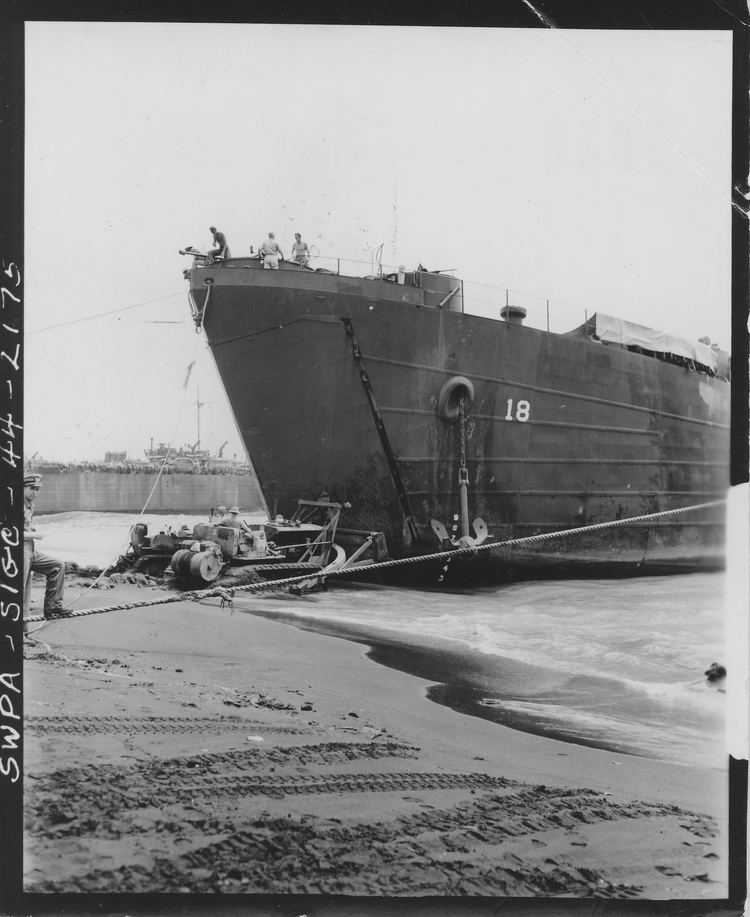Name LST-18 Sponsored by Miss Ruth Watt Decommissioned 3 April 1946 Construction started 1 October 1942 | Laid down 1 October 1942 Commissioned 26 April 1943 Struck 17 April 1946 Launched 15 February 1943 | |
 | ||
Operations Landing at Scarlet Beach, Battle of Cape Gloucester | ||
USS LST-18 was a United States Navy LST-1-class tank landing ship used exclusively in the Asiatic-Pacific Theater during World War II.
Contents
Construction and commissioning
LST-18 was laid down on 1 October 1942 at Pittsburgh, Pennsylvania, by the Dravo Corporation. She was launched on 15 February 1943, sponsored by Miss Ruth Watt, and commissioned on 26 April 1943 with Lieutenant John Lenci, USCGR, in command.
Service history
During the war, LST-18 was manned by the United States Coast Guard. She served exclusively and extensively in the Asiatic-Pacific Theater from September 1943 until November 1945.
LST-18 left Galveston, Texas, on 25 May 1943, with Convoy HK 186 headed for Key West, Florida, where she arrived on 29 May 1943.
She then travelled to Australia, where she left Caloundra, Queensland, on 23 August 1943, enroute to Townsville, Queensland, with Convoy QL 8, arriving on 26 August. From there she left two days later with Convoy TN 147 enroute to Milne Bay, Territory of Papua, where she arrived on 31 August 1943.
Eastern New Guinea operation
LST-18 participated in the landing at Scarlet Beach during the Battle of Finschhafen from 22–24 September 1943.
Bismarck Archipelago operation
LST-18 participated in the Cape Gloucester landings, New Britain at the end of December 1943 and January 1944. She then assisted in the Admiralty Islands landings at the end of March until 1 April 1944.
Hollandia and Western New Guinea operation
LST-18 remained busy participating in the Hollandia operation at the end of April and the beginning of May 1944, the Toem-Wakde-Sarmi area in the middle of May 1944, the Biak Island invasion in the middle of June 1944, the Noemfoor Island invasion at the beginning to the middle of July 1944, the Cape Sansapor landings at the end of July and the beginning of August 1944, and the Morotai landings in the middle of September 1944.
Leyte operation
From the Western New Guinea area LST-18 moved to the Philippines to participate in General Douglas MacArthur's promised liberation of the islands from the Japanese occupation starting with the Leyte landings from the middle of October until the end of November 1944.
LST-18 finished out her combat career participating in the Battle of Luzon Lingayen Gulf landings from the beginning to the middle of January 1945, the Palawan Island landings at the beginning of March 1945, and then the Visayan Islands landings at the end of March and the beginning of April 1945.
Postwar career
Following the war, LST-18 performed occupation duty in the Far East until early November 1945. She returned to the United States and was decommissioned on 3 April 1946. She was struck from the Navy list on 17 April 1946 and was sold to the Suwannee Fruit & Steamship Co., of Jacksonville, Florida, on 31 October 1946 for conversion to merchant service.
Honors and awards
LST-18 earned seven battle stars for her World War II service.
